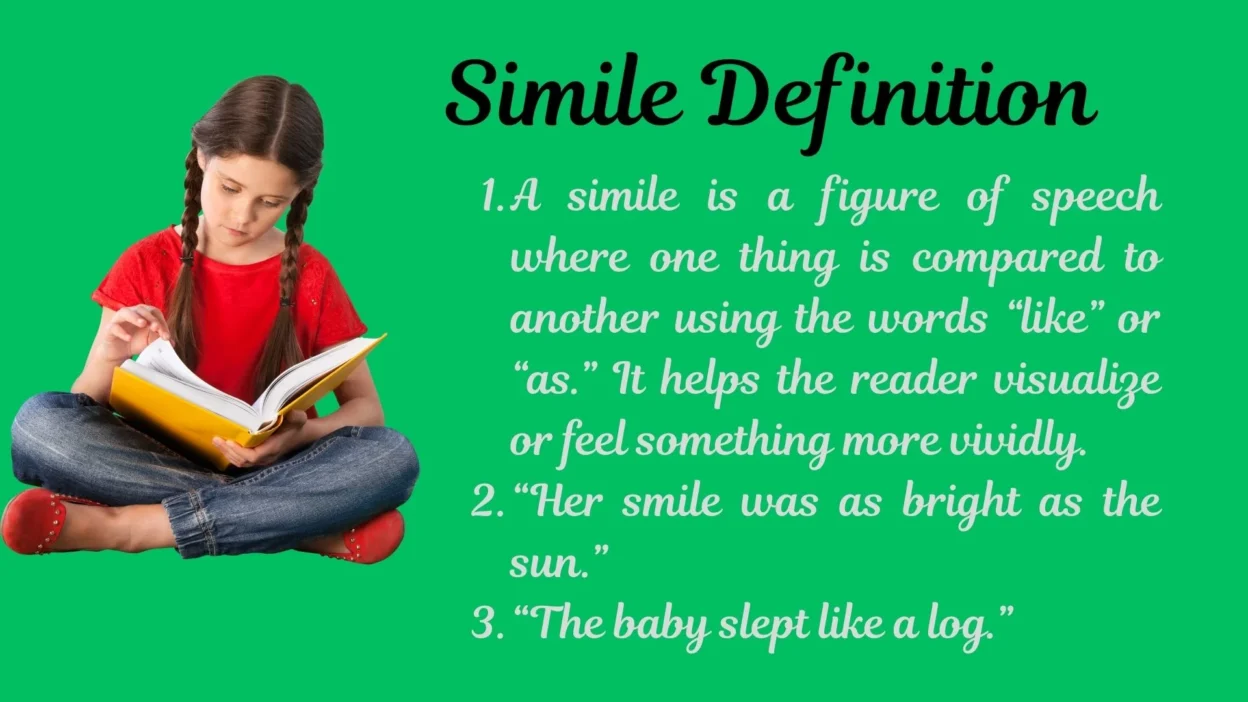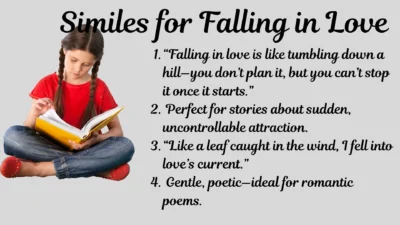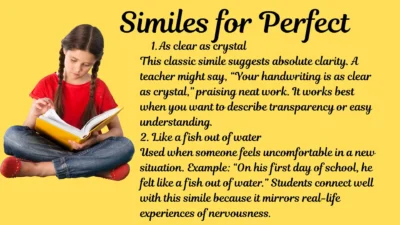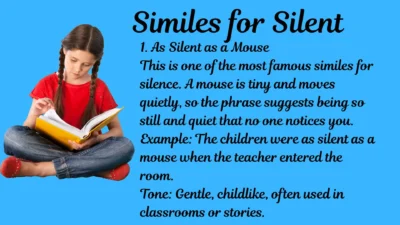Language becomes powerful when ordinary words are turned into extraordinary comparisons. That is where similes shine. If you’ve ever searched for the simile definition and meaning, you’re probably looking for clarity, practical examples, and guidance on how to use them effectively.
This article brings you everything you need: simple definitions, advanced explanations, 20+ simile examples in sentences, standout uses in literature and poetry, and even teaching approaches for students and kids.
Whether you’re a teacher, student, writer, or lifelong learner, this comprehensive guide will help you understand, apply, and master similes in everyday writing.
Simile Definition and Examples
A simile is a figure of speech where one thing is compared to another using the words “like” or “as.” It helps the reader visualize or feel something more vividly.
- “Her smile was as bright as the sun.”
- “The baby slept like a log.”
These comparisons make descriptions more memorable. Without similes, writing can feel flat and lifeless. With similes, ordinary ideas become imaginative.
Simile Meaning for Teachers
For teachers, explaining simile definition and meaning is about connecting abstract grammar rules to everyday life. Instead of only giving the textbook definition, teachers can ask students to think of moments when they describe things by comparing them:
- Saying someone is “as fast as lightning.”
- Calling a room “as cold as ice.”
Both children and teenagers understand naturally once they see that similes are already part of daily language.
Simile Definition Literature
In literature, a simile is more than just comparison—it’s a stylistic device that deepens storytelling. Writers use it to create mood, describe characters, and build imagery.
- In Homer’s The Iliad, warriors are compared to lions and storms.
- In Shakespeare’s plays, characters are often described with similes like “as merry as the day is long.”
These examples show that similes can be poetic, dramatic, or even humorous, depending on the writer’s intention.
Simile Definition for Kids
When teaching children, keep the definition simple:
A simile is when you say something is like or as something else.
Examples kids enjoy:
- “As busy as a bee.”
- “As hungry as a bear.”
- “He ran like the wind.”
Similes are fun for kids because they already use them in jokes, stories, and even playground talk.
Simile Examples Sentences (20+ Practical Uses)
Here are 20 simile examples in full sentences that students and teachers can use right away:
- She was as brave as a lion when giving her speech.
- The water was as clear as glass.
- His temper flared like a volcano erupting.
- The little boy slept like a rock.
- Her voice was as soft as silk.
- The exam was as tough as nails.
- The room grew as silent as a graveyard.
- The puppy was as playful as a clown.
- He was as stubborn as a mule.
- The soup tasted like heaven in a bowl.
- Her hands were as cold as ice.
- The toddler was as quick as a rabbit.
- The old car rattled like an empty tin can.
- His jokes were as dry as sandpaper.
- She looked as graceful as a swan on the stage.
- The clouds moved like ships on the sea.
- His words cut as sharp as a knife.
- The athlete ran as fast as lightning.
- The cake was as light as a feather.
- Her eyes sparkled like diamonds in the sun.
Simile Meaning and Examples for Students
Students often struggle with making writing descriptive. Learning similes can turn dull essays into exciting narratives. Teachers can encourage students to invent their own similes.
Example activity: Ask students to describe their school day using similes.
- “The classroom was as noisy as a zoo.”
- “My homework felt as heavy as a mountain.”
This approach not only teaches definition but also encourages creativity.
Similes in Literature
Similes have been used by writers across cultures and centuries. They bring texture and imagery to literary works.
- Homer’s Odyssey: Odysseus is compared to a mountain lion.
- Shakespeare’s Romeo and Juliet: Juliet’s beauty is compared to light—“as a rich jewel in an Ethiope’s ear.”
- Robert Burns: “My love is like a red, red rose.”
These show how similes elevate writing from plain description to art.
Similes in Poems
Poets especially love similes because of their rhythm and emotional punch. Some poetic similes include:
- “I wandered lonely as a cloud” (Wordsworth).
- “Like a bridge over troubled water” (Paul Simon, lyrics often treated as poetry).
- “My heart is like a singing bird” (Christina Rossetti).
Similes in poems help readers feel the emotions more deeply.
20 Similes Examples for Students
Here is a student-friendly list of 20 similes that are useful in classwork, storytelling, or exams:
- As blind as a bat.
- As sweet as sugar.
- As quiet as a mouse.
- As slippery as an eel.
- As sharp as a tack.
- As gentle as a lamb.
- As fresh as a daisy.
- As strong as an ox.
- As proud as a peacock.
- As dark as night.
- As old as the hills.
- As light as air.
- As neat as a pin.
- As flat as a pancake.
- As hot as fire.
- As cool as a cucumber.
- As white as snow.
- As red as a rose.
- As clear as day.
- As funny as a clown.
10 Standout Uses of Similes
Here are 10 standout similes explained in extra detail to show their power:
1. As brave as a lion
This simile is widely used for courage. Children understand it easily, and in literature it conveys heroism.
2. As cold as ice
Common yet powerful. It can describe physical coldness or emotional distance.
3. As fast as lightning
Perfect for sports writing, action stories, or dramatic poetry.
4. As light as a feather
Great for describing delicate things, often used in both everyday and poetic language.
5. As blind as a bat
Easy to understand and humorous. Suitable for students.
6. As proud as a peacock
A colorful simile that gives strong visual imagery.
7. As clear as crystal
Often used in speeches or writing to stress clarity.
8. As strong as an ox
A timeless simile for raw strength.
9. As sweet as honey
Romantic and simple. Works well in poems.
10. As hot as fire
Dramatic, intense, and universally understood.
List of Similes for Everyday Writing
Beyond classics, here’s a longer list of similes you can use in essays, stories, or teaching:
- As dry as dust.
- As bright as the moon.
- As calm as still water.
- As restless as a caged tiger.
- As funny as stand-up comedy.
- As quiet as falling snow.
- As tricky as a puzzle.
- As deep as the ocean.
- As tall as a giant.
- As warm as sunshine.
Simile Definition Literature vs. Everyday Use
In literature, similes are often layered with symbolism. In everyday speech, they’re straightforward.
- Literary: “Her eyes shone like twin stars in the night sky.”
- Everyday: “Her eyes sparkled like diamonds.”
Both are similes, but literature tends to push the imagery deeper.
Why Similes Matter in Communication
Similes improve storytelling, make lessons engaging, and bring emotion to everyday speech. They’re especially useful for:
- Students learning creative writing.
- Teachers making grammar lessons fun.
- Writers enhancing style.
- Speakers creating memorable lines.
Conclusion
The simile definition and meaning go far beyond grammar rules—they represent creativity in action. From students writing essays to poets crafting verses, similes enrich language by painting vivid pictures.
By exploring definitions, examples, and standout uses, this article has given you tools to master similes whether you are learning, teaching, or creating. Remember, similes are not just comparisons—they are bridges that make ideas come alive.




